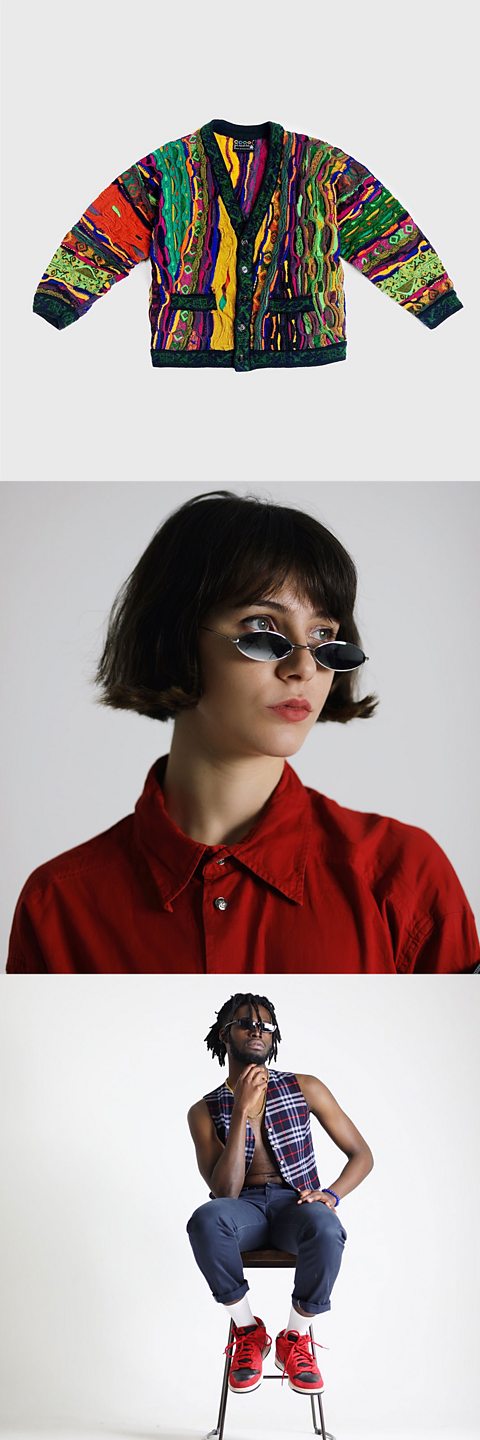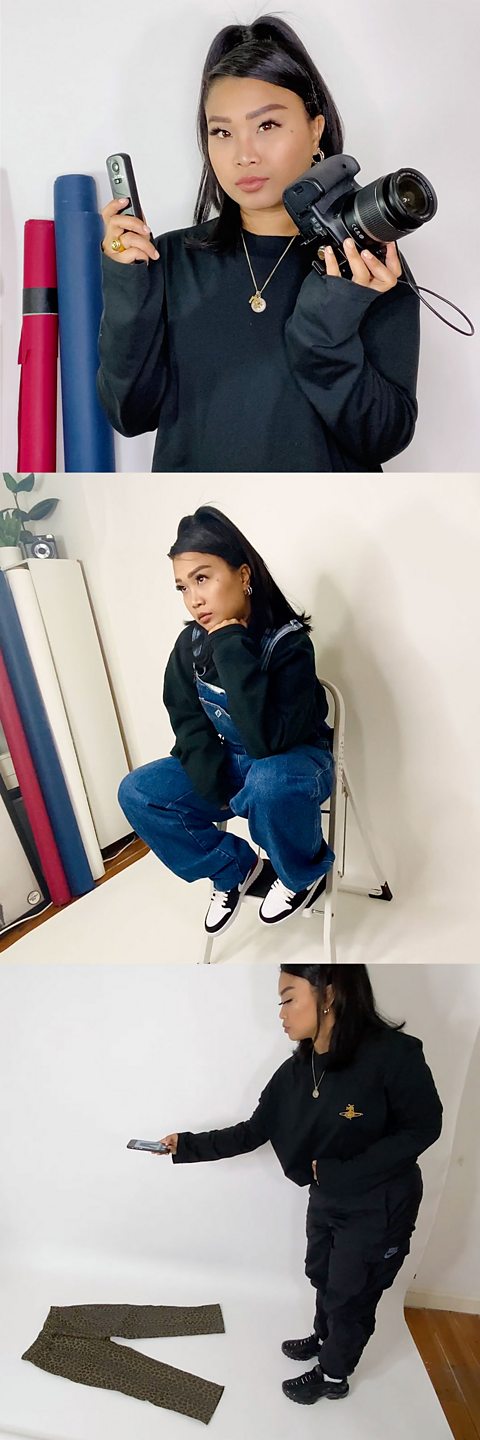It's been a challenging few months and, let's face it, none of us would say no to a bit of extra money in our pockets.
From picking up extra roles, to ramping up side hustles, people have been finding savvy ways to keep busy and make ends meet.Selling second-hand clothes online is an increasingly popular way to make some extra cash. Considering giving it a go? We caught up with online vintage fashion seller, T, who's made re-selling her full-time business, to find out her top tips.
Meet T
Brand: BASEMENT SIX
Platforms: Depop, ASOS Marketplace, own website
Followers: 59K (Depop)
Pro seller since: 2017
T: Hi everyone, my name is T, I am an online entrepreneur and I run an online vintage store called Basement Six.
Alright guys, so the first tip I would give you is decide at first what kind of background you want to use. Now you can shoot indoors with natural lighting or with studio lights behind a white wall, or a blank wall or with a backdrop, or you can shoot outdoors on location with natural lighting. This part is totally up to you, so maybe think about how you want your shop to look. Spend a little time thinking about the style that you want to produce and maybe have a browse through the shops that have inspired you.
My second tip is lighting. Now, if you're shooting indoors you'll want to try and get as much light as you can. I would recommend investing in a couple of photography or studio lights, these will in turn be a great tool to help you produce some really sharp and great images. I use ring lights for the middle section and then two soft boxes on either side, I then have my camera set up in the middle.
So the third tip is composition of the products that you're shooting. By this I mean are you shooting the products on yourself or a model, or are you shooting your product as a flat lay? I usually pick about four to six images per product that will include front, back, side and a detail shot. You can have a lot of fun with this, so spend some time here experimenting with what works for you.
So tip number four is styling. Now, you wanna think about the whole look that you are putting together. So, for example you might put a pair of dungarees with a sweater that you're also selling and combine those two products to create one image and a whole look. So think about shoes, think about accessories, think about what other products you can team with the product that you're also selling, but don't stress yourself out too much about this, I personally love this part of the whole process, so I spend a lot of time doing it.
Now my last tip is editing pictures. Now we can probably do a whole hour on how to edit your pictures, but today I'm just going to show you a couple of tricks that I picked up that really helped me when I first started. So I tend to edit the majority of my pictures on my tablet, but you can also do this on your smartphone. So the editing tip I'm going to give you today is making your pictures stand out a little more by colour correcting and brightening them. There are so many apps out there that you can do this with, for the majority of my pictures I turn up the exposure and play around with the contrast and highlights. It really depends on your picture and your personal preference.
The good thing about these apps is that most of them will have a setting where you can save your edits and apply this on to your other pictures instantly. This is great as it allows your pictures to be consistent throughout. I think this makes such a difference to an image and could potentially attract more people to the product that you're selling through your images. So that's it for now. I hope you find some of that interesting and helpful. Remember that vintage and second–hand clothing is not only unique and makes you look peng, trust me, you're also making a conscious decision to consume and sell clothes in a more sustainable way. Stay well, stay happy, stay healthy, stay wealthy and take care of each other. Bye.
Work out what you’re really good at and make the business work around you.
T's favourite part of online selling is styling and photographing the products. This is a really important to make your page look as eye-catching as possible. Don't panic, you don't have to have lots of fancy equipment or loads of knowledge to get started. T began with no specialist equipment and taught herself all about photography from YouTube.

T's top tips for stand-out images
1. Decide on your background
Think about where you want to shoot. You could shoot indoors, with natural or studio lights, and choose between a blank wall or a backdrop. Or, you might prefer to shoot outside on location and make the most of natural lighting. Have a browse of some shops you like for inspiration.
2. Get your lighting down
If you're shooting indoors, you want to get as much light as you can. If you're able to, it's worth investing in some photography or studio lights. You can totally make it work without these though! When I first started, I didn't have lights so I made the most of natural light, shooting when it was sunny.
3. Think about the composition
Consider how you want your shot to look. Are you going to shoot the product on yourself, on a model or as a flat lay? You probably want about four-six images for each product, including front, back, side and detail shots.
4. Have some fun with styling
Think about the whole look. For example, if you're selling a pair of dungarees, you could pair it with a jumper you're selling too. Think about shoes and accessories to complete the look.
5. Embrace the power of editing
There are lots of apps you can use on a tablet or smartphone to edit your pictures. A bit of colour correcting and brightening can make all the difference! Try turning up the exposure of your images and playing around with the contrast and highlights. The great thing is, in lots of the apps, you can save your settings and auto-apply them to other images to make all your product pictures look consistent.
If photography and styling aren't your thing, there are lots of other ways you can make yourself stand out from the crowd. Read on to find out more about how T built her business and her advice if you're thinking of giving it a go.



T's journey
When did you start selling clothes online?
Officially, I started around 2015. I came back from travelling skint and I'd always collected clothes and had a fashion background so one day I started selling at a car boot sale and then later took it online. I started taking it it more seriously around 2017, experimenting with aesthetics and developing the brand. I've always had an entrepreneurial streak! My gran lived opposite a tailors when I was little and I used to go and get spare material, make things and sell them to the kids down the road.
Did you know much about running a business before or have you learnt on the job?
No, I didn’t know anything! I'd sold some stuff on eBay at uni but that was it really. I used to have a part-time job with a fashion brand. The brand wasn't really my style and I didn't like the job at the time but, looking back, I learnt my ecommerce skills there – how to sell things online. Things like how to pack items well and do quality control. I thought I was falling behind at the time because I was in a job I didn't like but now I'm running my own business full-time!
How did you grow the business and expand?
By making loads of mistakes! It's important to figure out what works for you. For example, I sell more medium-to-higher-end products but less of it, whereas the opposite might work for you. Refine your strong points, your selling points. My favourite part is the styling and photographing so I've played to those strengths.
Networking is also important. I got into doing events with Depop and ASOS really early when I wasn't known in the vintage market because I took the initiative to approach them and I've built on that since. I'm an introverted person – no one ever believes me, but I am. I've developed a sort of persona when I'm doing talks and things that gives me confidence.


Three positives of online selling
- Everyone can do it – if you’ve got an internet connection, you can create an online shop and start selling straight away.
- You can do it from your bedroom – you don’t have to have a physical shop space like you used to. I started out with one tiny space in my flat to take the pictures, a makeshift phone holder and no lights. You can make it work!
- You can connect with other sellers – there are lots of communities on forums and social media where sellers support each other. It's nice from a social point of view as well as for business!
Three challenges of online selling
- Initially sourcing your products – don't ask experienced sellers for their sources as that's a no-no! You've got to get out there – try places like charity shops and car boot sales.
- Getting discouraged – don’t be too disheartened when there are bumps in the road. You can troubleshoot your problems. Item didn't sell? Why not reshoot the product and try again?
- Customer service – sometimes you may get customers who don't talk to you very nicely. Try not to take it personally and stay polite and calm.
Any advice for people who are thinking of giving it a go?
- Strike a balance – the world romanticises being busy all the time but you need a rest!
- Be authentic – your personality is part of the brand when you're selling online.
- Do your research – look through existing shops, find ones you like and see what they do.
- Keep creative – you've got to allow yourself to experiment so your brand doesn't get stuck in a rut.
- Give everything your best shot – any job or experience might help you out in future in unexpected ways!


Feeling inspired?
Find out more about what to expect from the world of online re-selling:

Young and in charge: is youth an advantage in business? video
Meet the young people making a success of being their own boss!
